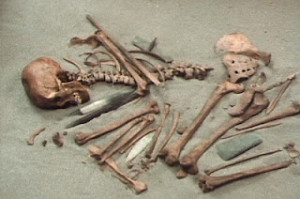ochre
Red Paint People
The Red Paint People, sometimes referred to as the Maritime Archaic culture of the north Atlantic coast of America, particularly Labrador, got their name from their habit of covering their dead with red ochre. They were a seafaring people who lived around 5000 BC. Similar discoveries have also been made in the State of Maine(e), where they flourished until they disappeared around 1800 BC , according to Hilary Nangle in a guide to Arcadia National Park.
A similar culture existed in northern Europe and both are  claimed, by ‘imaginative’ writers such as Shirley Andrews and Frank Joseph, to have been established by refugees from Atlantis after the destruction of their homeland.
claimed, by ‘imaginative’ writers such as Shirley Andrews and Frank Joseph, to have been established by refugees from Atlantis after the destruction of their homeland.
Slate tools of a similar type have been identified in Scandinavia and North America dated to around 3000 BC(b). Skara Brae in the Orkneys ha been claimed as an outpost of the Red Paint People(i).
Ivar Zapp & George Erikson recount[244.309] how bones discovered in similar stone chambers in Labrador and on the island of Teviec off France were both covered with red ochre and both dated to around 5500 BC. Richard W. Welch refers[630] to the Red Paint People as just part of a range of evidence to suggest that the Americas were originally settled by Europeans in prehistoric times.
There are also suggestions that the use of red ochre at burial sites may go back much further and would have been even more widespread.>Recently, ochre mining has been identified in a cave in the Yucatan and dated to 11,400-10,700 years ago(k).<
The Paviland Cave in south Wales held the skeleton of a young man dated to at the latest 19,000 BC. The most recent investigation has now pushed that date back to 33,000 BC(g).
The skeleton of a young child found at Abrigo do Lagar Velho in Portugal, was also discovered with red ochre and dated to 22500 BC(a). Further examples have been found across Europe and as far as Mesopotamia.
The discovery of further early trans-Atlantic links were announced in February 2012(c) by two archaeologists, Professors Dennis Stanford & Professor Bruce Bradley, in a newly published book – Across Atlantic Ice[1516]. Their claim is based on ‘Solutrean’ tools recently found in Delaware and five other east coast sites dated between 26,000 and 19,000 years ago. A sceptical view of their work should also be read(d). However, in 2016. the Soultrean Hypothesis was contradicted by genetic studies(f). Nevertheless, a recent documentary on the hypothesis has raised some controversy, as the program failed to refer to the use of the Soultrean Hypothesis by white supremacists(h). Jennifer Raff, who appeared in the documentary, has rejected the Stanford & Bradley theory in a new article(j).
The most ancient pyramid found in Mesoamerica at Chiapa de Corzo in Mexico contained the bodies of two rulers, coated in red pigment from head to toe. The pyramid is dated to around 700 BC. This may indicate a continuance of the same sacred custom over thousands of years.
Marcel Homet also discovered red painted skeletons in the Amazon region[813.180].
(a) See: Archive 2855
(b) See: Archive 3589
>(e) http://onlinelibrary.wiley.com/doi/10.1525/aa.1913.15.1.02a00050/pdf<
(i) https://historysmysteries.yolasite.com/red-paint-people.php
